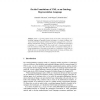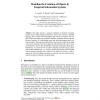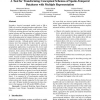63 search results - page 3 / 13 » Foundations of Temporal Conceptual Data Models |
EKAW
2004
Springer
13 years 10 months ago
2004
Springer
There is a growing interest in the use of UML class diagrams as a modeling language to represent domain ontologies. In a series of papers (e.g., [1,2]) we have been using the Gener...
FOIKS
2006
Springer
13 years 9 months ago
2006
Springer
This paper presents a semantic foundation of temporal conceptual models used to design temporal information systems. We consider a modeling language able to express both timestampi...
ICDE
1993
IEEE
13 years 9 months ago
1993
IEEE
To add time su port to the relational model, both first normal form (fNF and non-INF appmches have maining within 1NF when time support is added may introduce data redundancy. The...
APCCM
2006
13 years 6 months ago
2006
Data Warehouses (DWs) use an omnipresent time dimension for keeping track of changes in measure values. However, this dimension cannot be used to model changes in other dimensions...
DBA
2004
2004
A Tool for Transforming Conceptual Schemas of Spatio-Temporal Databases with Multiple Representation
13 years 6 months ago
Nowadays, classical conceptual models (such as ER or UML) are used for designing database applications. These classical conceptual models usually come with associated CASE tools a...



